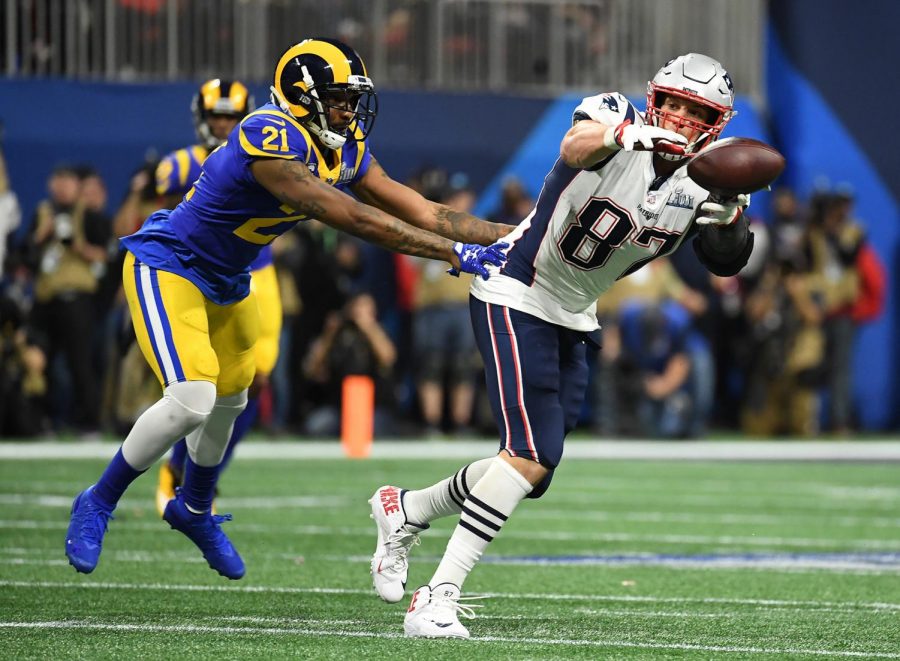Peckman: A somewhat comprehensive glimpse into this year’s Super Bowl ads
The good, the mediocre, and the incredibly trite.
New England Patriots tight end Rob Gronkowski (87) can’t catch the pass as the Los Angeles Rams’ Aqib Talib covers in the first quarter during Super Bowl LIII at Mercedes-Benz Stadium in Atlanta on Sunday, Feb. 3, 2019. (Wally Skalij/Los Angeles Times/TNS)
February 3, 2019
Mr. Peanut, Charlie Sheen, and Alex Rodriguez walk into a bar. Or a Planters commercial, rather.
Betwixt the barbaric battering of human flesh and the egregious amount of gambling and alcohol consumption America experiences on a certain Sunday every February, there are a few sacred minutes. Sacred, that is, to two groups of people — advertisers and nonsports people.
In 1967, when the National Football League’s big game first graced the silver screen, a 30-second television advertisement cost a mere $37,500, according to Nielsen Media Research. More than 50 years later, the amount has skyrocketed — now, the same 30-second spot costs corporations around $5 million.
I can assertively describe myself — generously, may I add — as a casual sports fan. I root for the Chicago Cubs, sporadically attend a football match (in the European sense of the word), and played baseball before the first iPhone was introduced. Where my interests mainly lie, as I casually sit cross-legged in a sweatshirt and faded jeans, are in the advertisements. Since a young age, when my Apple-loving mom introduced me to the ubiquitous 1984 Super Bowl spot, I’ve become somewhat of an advertising nerd.
RELATED: The art and heart behind graphic design
Super Bowl LIII was no exception to my supposed madness; as usual, the 30-second to minute-long “spots,” as they are called, tried their best to persuade me in a number of ways, whether I was meant to cry, laugh, or reach for my wallet based on the images in front of me.
Unsurprisingly, there were misses. These aforementioned ne’er-do-wells of advertising included but were not limited to Bud Light’s attempt at embedded marketing in a “Game of Thrones” commercial, M&Ms, and one (of the many) banes of my existence, YouTube TV.
More abhorrent than a specific advertisement, however, are a number of the overarching motifs I found while watching “the big game.” Corporations, for some reason or another, believe the average American viewer wishes to see sentient technology acting “funny.” Whether it’s TurboTax’s robot child who wishes to be a CPA when it grows up or the tried-and-true Sprint robots, it seems as though companies are attempting to capitalize on … the incredibly frightening nature of the progression of technology? Their motives seem rather unclear, but while viewing these commercials I felt physically uneasy.
One possible motive, however, is the need to avoid political backlash; in the last two Super Bowls, commercials such as Rams that used voiceover from Dr. Martin Luther King Jr., fell under fire instantaneously on social media and on Wall Street the next day. It seems as though robots and other “futuristic” technology are a safe way for large companies to immerse their viewers in a cutting-edge world (while avoiding all of that sticky political “stuff”).
There were numerous spots that left me with no feeling whatsoever. They weren’t detestable, but they weren’t 1984. For me, perfect examples of this were Pepsi’s “Is Pepsi OK?” and Doritos’ juxtaposition of Chance the Rapper and the Backstreet Boys. What these commercials lacked was creativity — often, media firms try to get the best “bang for their buck” (given the astronomical cost of advertising) by jam-packing their marketing with celebrity cameos. Often, this fails.
Then, of course, were the inevitable few that elicited a deep, satisfied breath. The Washington Post minute-long piece on the importance of journalism (narrated by the inscrutable Tom Hanks, i.e. “America’s Dad,” as he is referred to on social media). I also enjoyed Google’s “One hundred billion words” and the teaser trailer for Jordan Peele’s reboot of The Twilight Zone.
The general consensus, that is, a mere hour or so after the big game ended, seemed to be critical of this year’s advertisers. Did many companies play it safe? Yes. But did any spot cause the (inevitable) downfall of society? No. Despite this columnist’s rather cynical take on the “sports world” in general, I found myself lost in the magical world of big-budget advertising during Super Bowl LIII.






